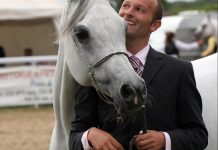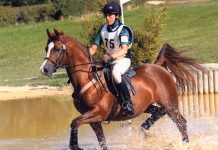Lady Anne Blunt, who died a hundred years ago on 15 December 1917, was a truly remarkable lady both in her own lifetime and in the legacy to the Arabian horse world that she has left behind.
On the face of it she was born, the granddaughter of the poet Lord Byron, into a wealthy if somewhat dysfunctional family with a privileged lifestyle. Lady Anne Isabella Noel Blunt, 15th Baroness of Wentworth, was born on 22 September 1837. She had a comfortable home and servants to attend to her every need. It sounds idyllic but the truth behind these facts was somewhat different. Her childhood was challenging and she was largely brought up by her grandmother and aunts while later on in life, her husband Wilfrid Blunt proved to be a difficult character. However, Lady Anne was highly intelligent and had many talents for painting, writing, music – she was a talented violinist who owned two Stradivarius violins, one of which has since been named after her and is the most expensive violin in the world – and she was a gifted linguist, being fluent in several languages as well as riding and appreciating horses. Her detailed journals and watercolours provide a vivid backdrop to her extraordinary travels.

The Blunts in the desert.
Wilfrid Blunt, poet and would be politician, was intrigued by the quiet, self-possessed intelligence of Lady Anne and they married in 1869. With their combined interest in Arabic culture, they set out in 1877 on an historic journey to explore the Middle East, journeying from Beirut, across northern Syria, and south through Mesopotamia to Baghdad in Iraq. Lady Anne had a long family background in horses and having spent time with the British Consul in Aleppo, James Skene, the Blunts soon adopted a plan originally conceived between Mr Skene and Major Roger Upton some four years earlier; to try to find the best Arabians they could and bring them back to England. In this way, they could both preserve the already rare and endangered Arabian bloodlines, and also infuse the English Thoroughbred with more of the Arabian blood from which that breed had originated. Lady -Anne encompassed their thoughts with an often-quoted phrase:
“We have made a plan … of importing some of the best Anazeh blood to England and breeding it pure there…it would be an interesting thing to do and I should like much like to try it.”
What followed was the first of two epic journeys, expertly described in Lady Anne’s books each of two volumes, The Bedouin Tribes of the Euphrates and A Pilgrimage to Nejd.

The famed photo of Lady Anne on Kasadi.
At the start of their journey, guided by James Skene, they travelled among fierce and often warring Bedouin tribes; the Blunts barely knew a handful of words of Arabic and even those were often of little use as the many dialects varied enough to be almost different languages. During their travels, however, Lady Anne, who was an adept scholar, became an authority on the Arabic language, learning to speak it fluently. She gained the trust and respect of the Bedouins even so far as to be asked to arbitrate on the meanings of ancient texts. The Bedouins prized their horses above all else and only rarely parted with them. Outside buyers were usually sold impure, low quality horses, often with false pedigrees, but thanks largely to Lady Anne’s intelligence and integrity, the Blunts made friends among the Bedouins and were able to buy their first Arab horse in January 1878. This horse was the hugely influential Dajania and just six months later, she became one of the founding stock as the Crabbet Stud was officially formed in July of that year.
The Blunts next purchase, their first stallion, was Kars whose story is perhaps even more remarkable than that of the Blunts expeditions themselves…
You can read the article in full in the current edition of The Arabian Breeders’ Magazine – buy your copy on our online shop www.thearabianmagazineshop.com












